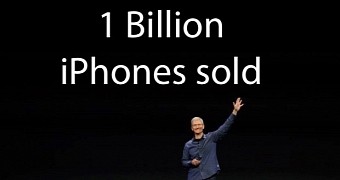If you're wondering exactly how many iPhones Apple has sold since Steve Jobs unveiled the first iPhone model in June 29, 2007, I have a very good approximation thanks to Tim Cook, who said during the March 9, 2015 Apple Watch conference that Apple had sold a total of 700 million iPhones to date.
In order to get as best of an approximation as possible, I needed the exact number of iPhones sold by Apple during the second and third quarter of 2015, the months after Tim Cook's estimation of the total number of iPhones ever sold.
As it happens, Apple has been courteous enough to publish the exact number of iPhone units sold per quarter in the quarterly financial results reports on available on the Apple Press Info website.
According to the data available in the financial reports for the second and third quarters of 2015, Apple sold 61.17 million iPhones during the Q2 2015 and 47.53 million units during Q3 2015.
This amounts to 108.7 million iPhones sold worldwide during the two quarters, and if we take into account the previous sales trends reported by Statista, Apple should report almost identical results for the fourth quarter of 2015 to the ones for the third.
This would mean that, in Q4 2015, they should sell between 2 and 4 million more iPhones, which allows me to approximate the total number of iPhone units sold in Q4 to 49 million.
Apple should sell 857.7 million iPhones until 2015 ends
Taking all of the above into account, Apple will have sold 857.7 million iPhones until the end of 2015.
Although this does not seem that close to the 1 billionth iPhones I mentioned in the title, hang on with me for just a little longer because it is not that hard to make an educated guess of the date Apple will sell it on (and it is definitely not that far in the future as you would think).
After taking into consideration that each year the number of iPhones sold has increased and crunching the numbers, I came up with the following increase rates between 2012 and 2016:
| Year | Millions of iPhones sold | Percentage of sales increase |
| 2012 | 125.04 | - |
| 2013 | 150.26 | 16.79% |
| 2014 | 169.22 | 11.21% |
| 2015 | 232.17 | 27.12% |
| 2016 | 284.53 | 18.37% (estimated) |
Therefore, after calculating that the arithmetic mean of sales growth per year since 2012 is 18.37%, I used it as the possible increase in iPhone sales between Q4 2015 and Q4 2016.
Adding it all up using Spotlight (I know, OS X is smart like that), I came up with 284.53 million iPhones to be sold by Apple during 2016.
The one billionth iPhone should be unboxed in June or July 2016
If we spread all these iPhones per quarter, somewhere between 2016's quarters, we see that around the middle of the year (in June or July), Apple will send their one billionth iPhone to their one billionth iPhone customer.
To finish it all up, if you are still curious, Apple should sell a total of 1.142.230.000 iPhone units until the end of 2016 since the first iPhone was launched.
To put things into perspective, as I previously reported, Apple said that they experienced record iPhone 6s and iPhone 6s Plus sales during the first weekend after the launch, amounting to 13 million units.
If you consider everything I wrote about and think about the numbers, it is quite easy to see why they are a maximum of 2% of all iPhones present in the wild, as I wrote in an article published yesterday about the slower adoption rates of the 6s and 6s Plus when compared to last year's iPhone 6 and 6 Plus.

 14 DAY TRIAL //
14 DAY TRIAL //